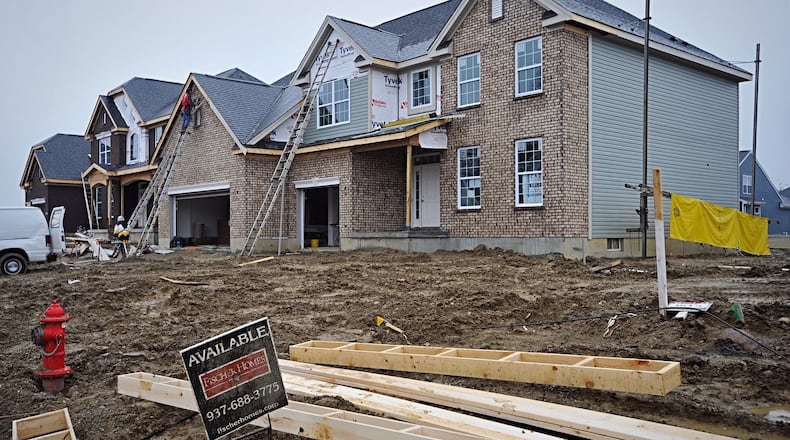“We are open to growth, we are open to development,” said Huber Heights Mayor Jeff Gore.
In the past, Gore said he felt the city was not seeing the same growth that cities south of Dayton were seeing, despite being located close to the “crossroads of America,” at Interstate 70 and Interstate 75.
“Huber Heights always seemed to be the red-headed stepchild of Montgomery County. All the money and things was all going south of town, the 675 interchange was booming down there, but not so much up here,” Gore said.
Since 2008, there have been nearly 1,400 homes built in Huber Heights. The number of homes built in the city has trended upward steadily since the Great Recession. In the past five years, the amount of homes built in Huber Heights increased by nearly 130%.
Much of the growth has been in the portion of Huber Heights that is in Miami County, Gore said.
In 2018, 181 new homes were built in Huber Heights. Last year, 208 units were built, according to city data.
Sham Reddy, the new president of the Dayton Realtors, said Huber Heights is a popular suburb for first-time home buyers and a “fall back community” for Air Force families, but the suburbs south of Dayton are still the most popular in the Dayton-region.
“Huber is the next alternative to the southern suburbs because it has a decent school district and mostly new buildings north of I-70,” Reddy said.
Most of the housing stock in Huber Heights are ranch homes and brick homes, Reddy said.
According to data given to the Dayton Daily News from the Dayton Realtors, the average number of days a home is on the market in the Dayton area is 80 days. In Huber Heights that number is 67.
Reddy said the only area north of Interstate 70 that has a “hot” housing market is Huber Heights. The other hot markets in the region are all south of Dayton, like Kettering and Springboro.
Carriage Trails
Eric Farrell, the CEO of the Home Builders Association of Dayton (HBA), said the Carriage Trails subdivision has experienced tremendous growth in the past couple of years.
According to HBA of Dayton data, in the first 11 months of 2019, 183 residential building permits were pulled in Huber Heights.
After the recession, Gore said, Huber Heights was one of the only areas in the Miami Valley where build-ready lots were available.
“We had all these build-ready lots and banks weren’t lending money after the recession, so if you wanted to build a new home, this was one of the only places to do that,” Gore said.
Of the 208 houses built in Huber Heights in 2019, 132 of them were in the Carriage Trails subdivision, according to city data.
Because of the large number of homes that have been built there, Gore said he predicts the city will see a higher population count in the upcoming 2020 Census.
In the 2010 Census, Huber’s population was 38,101, which was down slightly from the count in 2000 at 38,212. The population was estimated to be about 38,174 in 2018, according to Census bureau data.
“Of course we won’t know until the count happens, but the trends appear to be heading that way,” Gore said.
New investment in the city
In the past two years, 76 new businesses came to Huber Heights.
“There was kind of a void up here,” Gore said. “The whole region… it wasn’t getting the love I thought we should have been getting.”
Gore said Trimble was looking to move its headquarters out of Ohio a couple years ago, but decided to stay and has made new investments in the city since then.
The new businesses have brought a more than $57 million investment into Huber Heights. Eleven of those 76 business investments were new construction in the city. Others, like At Home and Burlington, were investments to an already existing space.
According to city estimates, from2015 to 2017, the city saw about $48 million in investments from businesses.
“When something comes available, we don’t have (space) just sitting open like we used to,” Gore said.
And it’s not just large corporations that are investing in Huber Heights, Gore said. Several small businesses, like City Coffee House and Prater Designs and More have opened in the city in the past year.
Chris Kershner, the executive vice president of the Dayton Area Chamber of Commerce, said that Dayton’s economy is doing well “all across the board.”
“All areas of the Dayton region have unique things that attract businesses to them to the area,” Kershner said.
Gore said a good U.S. economy has aided growth in Huber Heights.
“The economy is very good in the U.S. right now, and as long as consumer confidence is up, Huber is poised to grow with everything else,” Gore said. “We’ve got space for redevelopment and development.”
Gore said the city is poised for even more growth in the coming years.
“The northern communities are close to I-70, which many companies see as a strategic advantage,” Kershner said.
Calculated risks
Although the city is growing, Gore said he doesn’t see the city asking taxpayers for more money any time soon. The city increased the income tax by a quarter of a percent a couple of years ago, he said.
Other nearby cities have had to consider increasing taxes to keep up with their growth. Fairborn, for example, has also seen marked growth and will ask taxpayers to consider increasing the income tax to support fire and police operations in the city in March.
“We have sought out and created opportunities for growth,” said Huber Heights City Manager Rob Schommer. “In recent years, we have been more aggressively seeking out those opportunities. We’ve been taking calculated risks, and we can go back in history and show that the calculated risks have paid off.”
One example of the calculated risks the city has taken is building the Stewart and Mimi Rose Music Center in 2015. Some citizens worried the city was biting off more than it could chew, but the popular concert venue has seen year-over-year growth in ticket sales and other revenues.
The recent success of the Rose Music Center has also allowed the city to invest more funds into its parks, Schommer said.
BY THE NUMBERS
91 - number of homes built in Huber Heights in 2014
208 - number of homes built in Huber Heights in 2019
$57 million - the amount businesses have invested in Huber Heights since 2018
SOURCE: Huber Heights city data
About the Author

